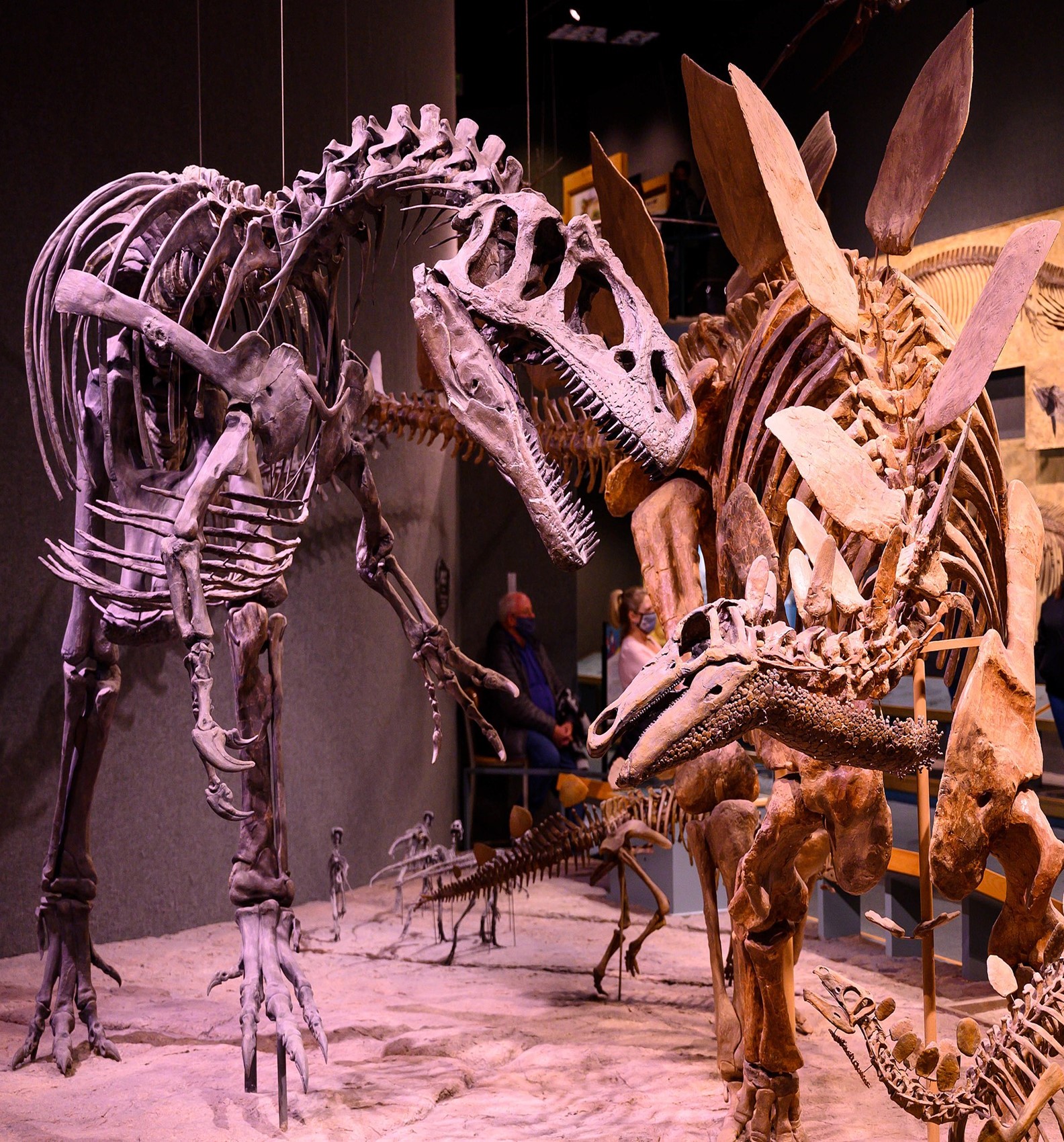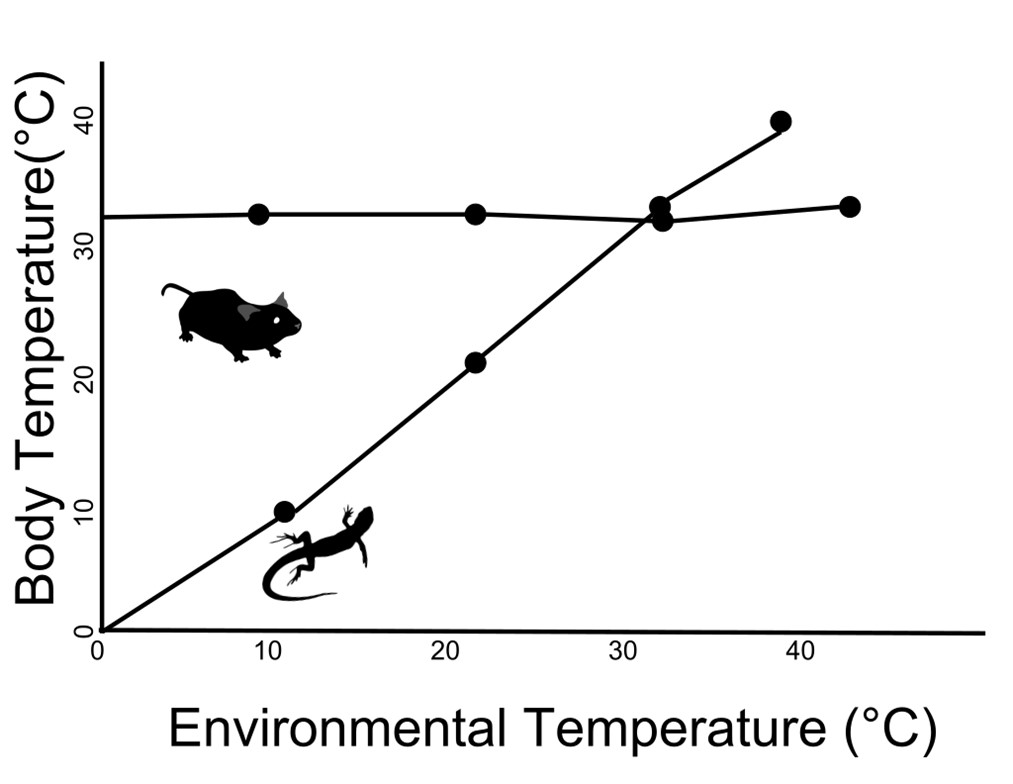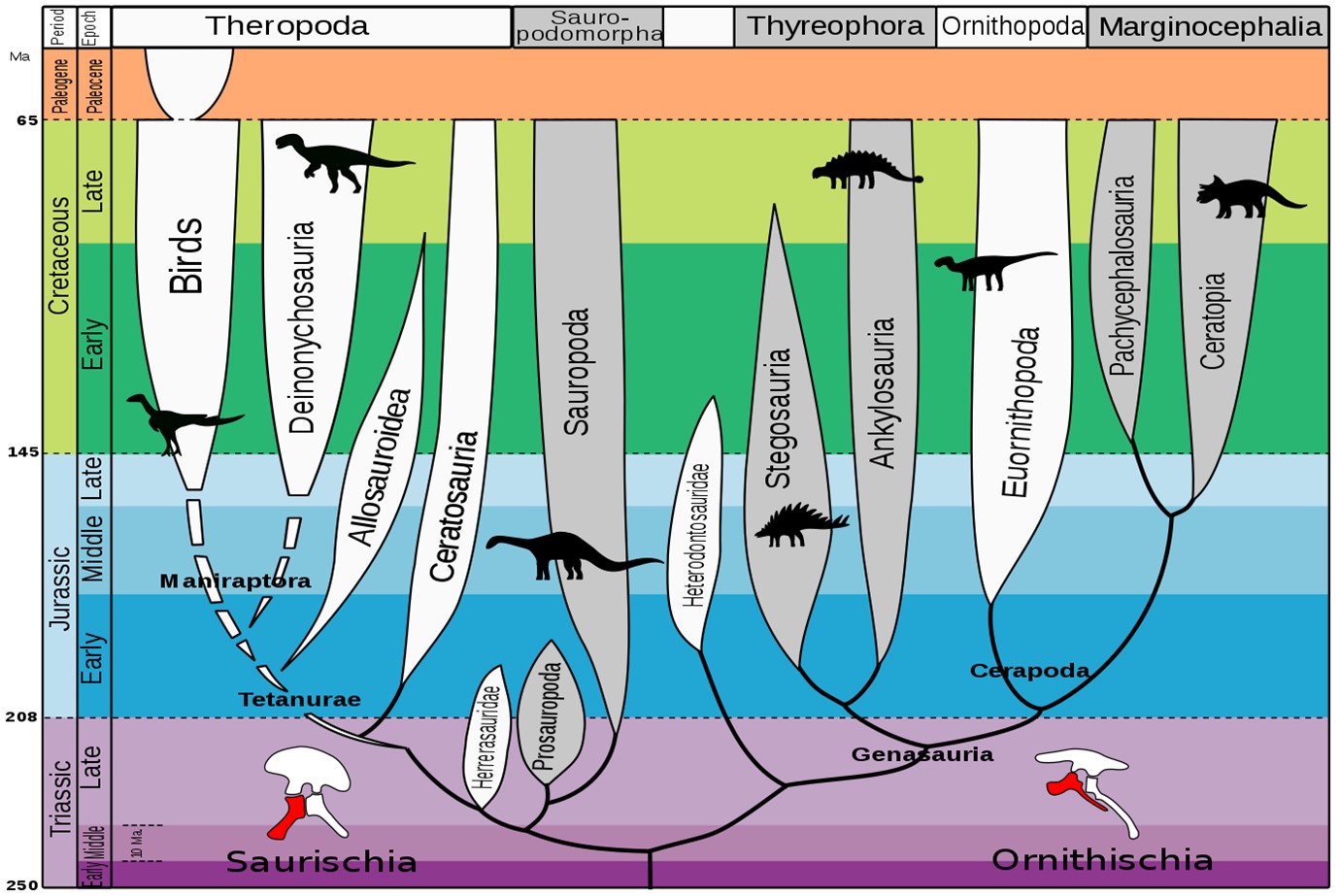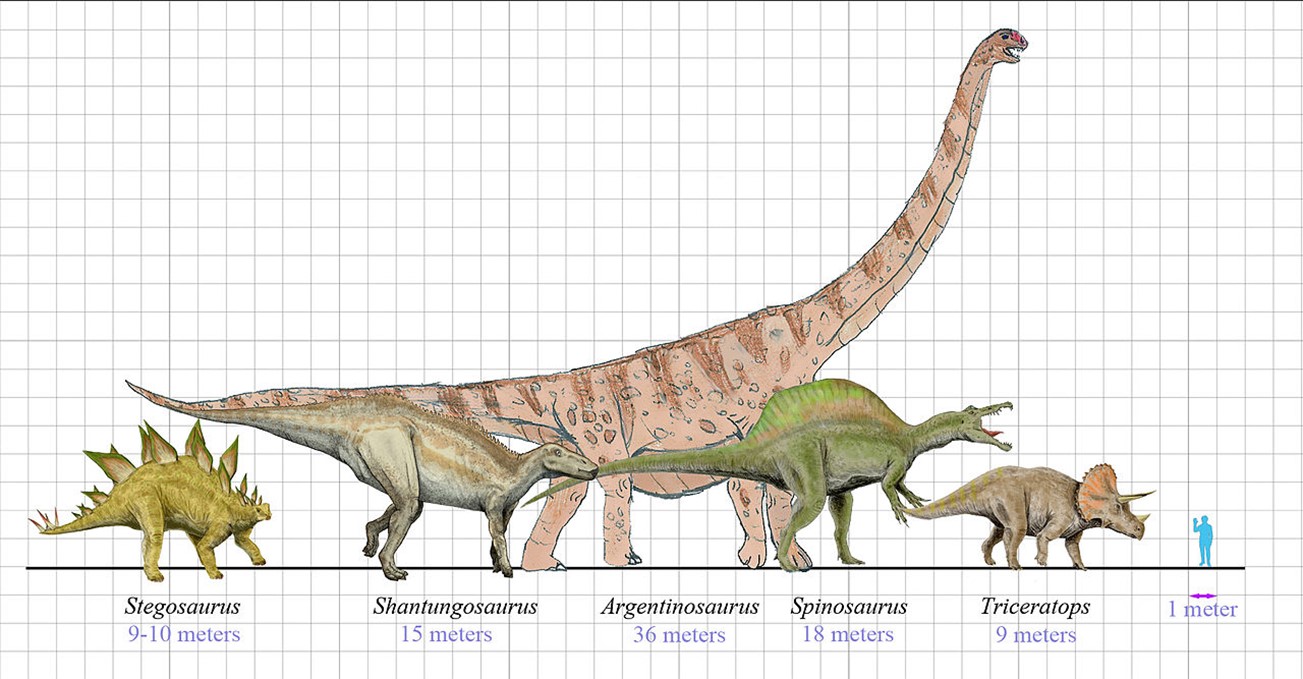
Credit: David Wipf, via Wikimedia Commons
When dinosaurs were first discovered, scientists thought they must have been cold-blooded like the lizards they resembled.
Later, they realized that some dinosaurs are related to modern birds—which have the highest metabolic rate in the animal kingdom. Could dinosaurs, too, have been warm-blooded?
New research reveals the answer is: both.
So-called “cold-blooded” creatures, or ectotherms, are confined mostly to mild climates. They’re more sedentary but require less food and oxygen to survive.
Warm-blooded creatures, or endotherms, can thrive in and migrate to diverse climates—but expend much more energy to maintain constant body temperatures.
All creatures take in oxygen, and new research shows that the waste products of processing that oxygen—different in warm- and cold-blooded animals—are durable enough to be found in fossils.
Molecular analysis of dinosaur fossils suggests an evolutionary break, with cold-blooded, slow-moving herbivores, like Stegosaurus, on one branch, and warm-blooded, highly mobile predators, like Velociraptors, on another.
Larger dinosaurs like Brontosaurus and Tyrannosaurus also had high metabolic rates, but not as high as the ravenous Velociraptors.
These findings indicate that dinosaurs evolved different metabolisms and body temperatures for different environmental niches—just as today’s animals have.
Background
Synopsis: Early paleontologists imagined dinosaurs to be lumbering, lizard-like creatures, so anticipated they would be similarly cold-blooded, like their crocodile cousins. But the only dinosaurs that survived extinction 66 million years ago are today’s warm-blooded birds, with high metabolic rates. Recent studies that tie byproducts of oxygen respiration preserved in bones to metabolic rate suggest a different story that will challenge many paradigms about the past.
- For decades paleontologists have pondered the question of thermoregulation in dinosaurs—were they cold-blooded, warm-blooded, or somewhere in between?
- Thermoregulation describes an organism’s ability to maintain its body temperature within certain physiological limits when external temperature is quite different.
- Metabolic rate measures how effectively an animal converts the oxygen they breathe into chemical energy that can be used by their bodies for activity and to regulate body temperature.
- At one end of the thermoregulation spectrum, ectotherms are “cold-blooded” animals that rely on their environment to regulate their temperature, basking in the sun or sheltering in the shade.
- Ectotherms consume less food and oxygen because they operate at economical metabolic rates, must live where temperatures are fairly consistent, and most tend to be sedentary.
- Almost all fish, amphibians, reptiles and invertebrates are considered to be ectotherms.

The warm-blooded mouse consumes more food and oxygen to maintain a constant body temperature while the cold-blooded lizard’s body temperature depends on its environment.
Credit: Jordan hawes, via Wikimedia Commons
- At the other end of the spectrum are endotherms, warm-blooded creatures with higher metabolic rates.
- Endotherms produce the energy to maintain a constant body temperature by consuming larger quantities of food and oxygen.
- They use strategies like shivering to warm themselves in the cold or sweating to cool themselves in the heat.
- They are able to range more easily at night and into environments that are cooler, such as mountainous or high latitude terrain.
- Almost all birds and mammals are endothermic, with birds having the highest metabolic rates of the animal kingdom.
- Some organisms that use mesothermic strategies alternate between ectothermic and endothermic, with the ability to regulate their body heat, but not to a constant temperature like mammals and birds do.
- A tuna typically maintains a body temperature about 36°F (20°C) warmer than the surrounding seawater, except when it dives into cold, deep water, causing its metabolic rate to plummet.
- In 1824, an Oxford University professor named William Buckland correctly identified fossilized bones found in England as belonging to an extinct carnivorous lizard-like reptile. In 1842, this group of fossils was named Dinosauria.
- Because they were considered to be lizard-like, most scientists imagined these creatures to be cold-blooded, like modern crocodiles.
- However, the only living descendants of the dinosaurs—modern birds—are warm-blooded with high metabolic rates (ED-030 Dinosaurs in Your Backyard and ED-291 Tyrannosaur on Your Table).
- Over the past decade, improved technologies and a few new lines of evidence have suggested higher metabolic rates for dinosaurs.
- Several studies have identified traits in dinosaur fossils that are found in modern endotherms, such as the presence of specific lung attachment and air sacs to increase oxygen intake during breathing (as found in birds), and structures in the nasal cavity to increase air temperature (found in both birds and mammals).
- Studies on the microstructure of bones in vertebrates have identified several groups of dinosaurs, particularly theropods (a group of carnivorous dinosaurs that includes T-rex and modern birds), as showing high metabolic rates associated with endothermy.
- A study of dinosaur eggshell geochemistry published in 2020 used clumped isotope paleothermometry to analyze chemical bonds in a variety of fossilized eggshells, concluding that body temperatures of mother dinosaurs ranged from around 6°F (3°C) all the way to 27°F (15°C) warmer than their surrounding environments.
- Discoveries of a variety of dinosaur hatchling remains along Canada’s Colville River would have required up to six months of incubation in paleo ecosystems, with fossil plants indicating a similar climate to that of Ottawa, Canada, suggesting that dinosaurs ranged into cooler environments and might have even lived there year-round.
- Some of the most compelling evidence to date comes from a recent study published in Nature that looked at metabolic byproducts preserved in the femurs of 25 living animals and compared them to 30 fossilized animals.
- Creatures with high metabolic rates produce heat as they consume oxygen during their breathing process.
- Oxygen byproducts react with biomolecules such as proteins, fats and sugars to produce waste products that are stable enough to be preserved during fossilization, creating a record of oxygen use that reflects metabolic rate.
- The researchers used Raman spectroscopy and Fourier-transform infrared spectroscopy to measure these chemical leftovers at the molecular level. These methods work like laser microscopes, without destroying the samples under examination.
- The data collected from living animals was compared to their metabolic rates; then, the results from the fossils were statistically fit in among the modern creatures, inferring a rough estimate of their metabolic rates.
- The scientists found a continuous range of metabolic rates among the fossils with two remarkable trends tied to an evolutionary break during the Triassic Period: saurischians had higher metabolic rates, while ornithischians were characterized by slower metabolic rates.

Evolution of dinosaurs, with typical silhouettes shown in black. Lizard-hipped saurischians are shown on the left and bird-hipped ornithischians on the right. Differences in their pubis bones are shown in red. Modern birds are not ornithischians; they evolved from lizard-hipped therapod saurischian dinosaurs.
Credit: Evolution_of_dinosaurs_by_Zureks.svg: Zureksderivative work: Woudloper, via Wikimedia Commons - Within the saurischians, huge herbivorous sauropods like Brontosaurus and Diplodocus were found to have high metabolic rates, while theropods like Velociraptor demonstrated even higher metabolic rates.
- Many theropods were feathered, and some of them gave rise to the avian dinosaurs, today’s hot-blooded birds.
- The highest fossil metabolic rates were determined for the saurischian theropod predator and scavenger known as Allosaurus. These terrifying creatures would have been relentlessly hungry to fuel their energy needs.
- Tyrannosaurs had a slightly lower metabolic rate than other carnivorous theropods.
- Reptilian flying pterosaurs and marine plesiosaurs were also found to have evolved higher metabolic rates.
- As for the ornithischians, Stegosaurus, Triceratops and duck-billed hadrosaurs appear to have had slower metabolic rates similar to modern lizards, crocodiles and alligators.
- The research suggests that these animals actually evolved to become more cold-blooded than their warmer-blooded ancestors over time.

Comparison of dinosaur sizes featuring saurischians Argentinosaurus (118 feet or 36 meters) and Spinosaurus (59 feet or 18 meters) and ornithschians Shantungosaurus (49 feet or 15 meters), Stegosaurus (33 feet or 10 meters) and Triceratops (30 feet or 9 meters).
Credit: Zachi Evenor, via Wikimedia Commons
- The research suggests that these animals actually evolved to become more cold-blooded than their warmer-blooded ancestors over time.
- These new findings are intriguing, and scientists will be working on the implications of variable metabolic rates on their understanding of evolution, growth rates, food requirements, habitat preference and ecosystem development through time.
- If some non-avian dinosaurs were warm-blooded, their extinction 66 million years ago must be attributed to something other than metabolic rate, such as their size, food sources, and reproductive strategies.

